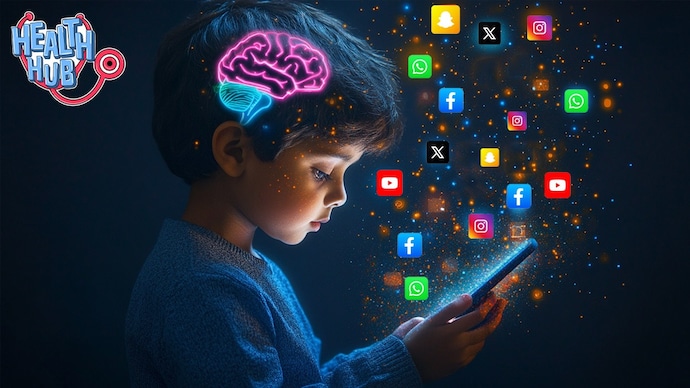Repetition of childhood: Dangerous effect of social media on your child’s brain
Increasing concerns about the influence of social media on children under 16 years of age have called strict rules, as experts highlight their harmful effects on mental health and development.

In today’s digital world, smartphones and social media are almost universal among young people, especially children. By the age of 10, their brain undergoes a significant change, where they enter a phase to approval and pay attention to others.
Psychologists have found that during adolescence, the reward system of the brain undergoes significant changes. “Happy hormone” – Oxytocin and dopamine – an increase in ventral strutam, a region of the brain is associated with social awards.
According to Mich Princestein, Chief Science Officer of the American Psychological Association, social media activities are closely associated with this brain region. “Whenever we experience social awards, the region gets a dopamine and oxytocin congestion,” he explained.
There is a ventral palidam around the ventral strutam, which is responsible for the induced tasks. While social media activates adult brain reward centers, the effects of adults are less harmful due to their own stable feelings and more developed prefrontal cortex, which controls emotional reactions.
Countries like Australia are addressing the influence of social media on teenagers. Australia’s Communications Minister proposed a law banning children under 16 years of age, highlighting the challenges of online security.

Dr. Mitchell Shah, a psychologist and Harvard researcher supports such restrictions citing the harmful effects of social media on mental health. She advocates systemic changes how children connect with digital platforms.
Social media neurological effects
Social media oversstems the reward system of the teenage brain, which leads to a cycle of immediate satisfaction. Dr. “This quick reward system looks for constant stimulation to the brain, impulses the impulse control and decision -making skills,” says Shah, “Dr. Shah says.
A 2023 study at the University of Northern Carolina found that repeatedly checking social media among young teenagers aged 12 to 13 could be associated with their brain changes in three years.
Teenagers who examined social media often became more sensitive to social response, more than 15 times.
According to the researchers, social media platforms offer a constant and unexpected stream of social reaction in the form of choice, comments, information and messages.
Due to this, teenagers become hypersensitive to their peers to respond.
Mental health concerns
The use of heavy social media is strongly associated with mental health issues such as anxiety, depression and loneliness. Dr. Shah note that platforms expose users to a continuous discovery for cyberbulling, unrealistic beauty standards and verification. “Curated personality makes a false reality online, which makes children feel insufficient,” he said.
In Europe, about 8–17% of the teenagers aged 12–16 years say they fall into harmful materials at least once a month. According to a 2024 study published in BMC Journal of Child and Adolateable Psychiatry and Mantle Health, about 10% of them have seen posts about drug use, suicide methods or self-loss.
The popular social media platforms used by teenagers contain frequent visible materials. For boys, it exposes muscles and athletic body types, such as Big Biceps, a V-shaped torso, and visible abs. For girls, it promotes thin waist, low body fat and a noticeable movement or hips, yet to be shapely.
Social and emotional development
Familiar interaction is important for the creation of sympathy and emotional understanding. Social media, however, emphasizes superficial connections, causing children to be unmaporated for real -life relationships. “Without the practice of the real world, children can struggle to explain the language of the body, resolve conflicts or make real relations,” Dr. Shah warned.
A ban on social media for children under 16 years of age is not just about the ban. Its purpose is to create a safe environment for development. Dr. Shah said that the unexpected content of social media disrupts executive functions such as flow focus and impulse control. Prolonged screen time also affects sleep, physical activity and creative sports opportunities, all are important for development.
Break the cycle of comparison and anxiety
Social media enhances the issues of anxiety and body image by promoting unattained beauty ideals. Dr. Shah noted, “It makes a loop of the social comparison above, eliminates symptoms of low self -esteem and depression.”
By removing social media as a source of verification, children can focus on internal satisfaction and real -world achievements.
Encourage healthy options
Dr. Shah recommended to change social media with rich activities:
- Outdoor activities: Hiking and team sports reduce stress and create flexibility.
- Creative Search: Art, music, and crafting enhance focus and emotional expression.
- Community participation: voluntarily promote sympathy and teamwork.
- Offline sports: Chess and puzzles develop important thinking and patience.
- Physical exercise: Yoga and dance improve mood stability and sleep.
- STEM projects: Uses on hands stimulate curiosity.
- Mindfulness practice: Jernling and meditation enhance self-awareness.
Low screen time benefits
Cutting screen time improves sleep quality by reducing the risk of blue light, which disrupts melatonin production. Quality sleep increases emotional regulation and cognitive performance.
Structured screen deadlines can lead to healthy routines and better educational results.
In today’s digital age, it is necessary to prioritize offline experiences and authentic relations for mental health and development of young people.







